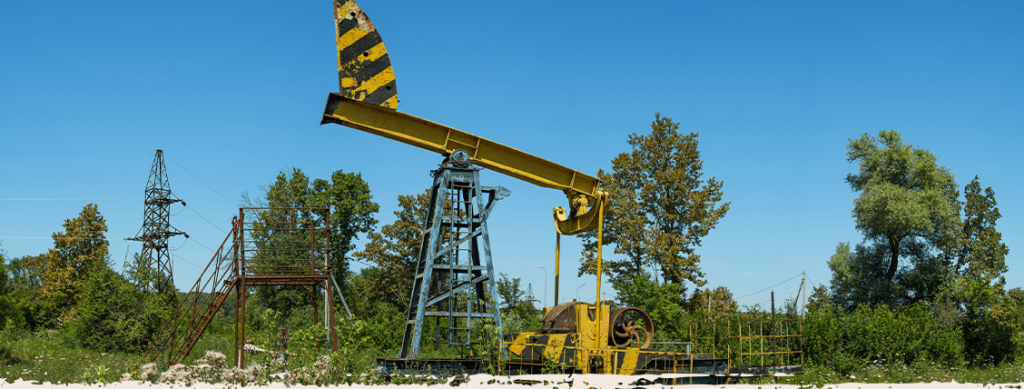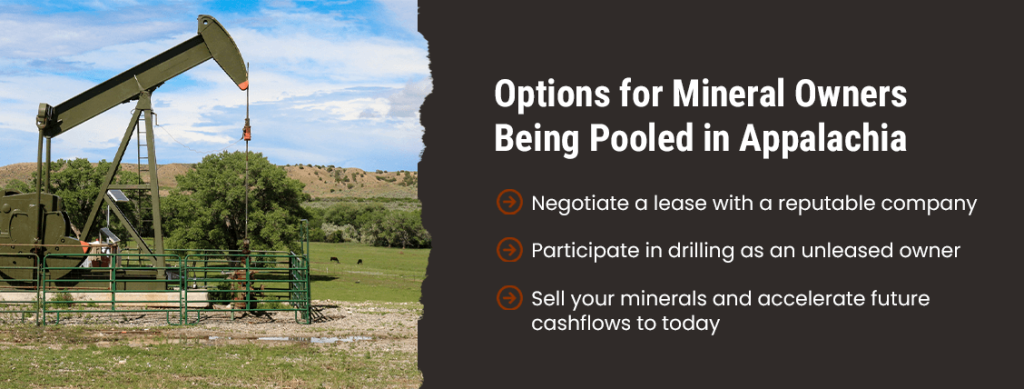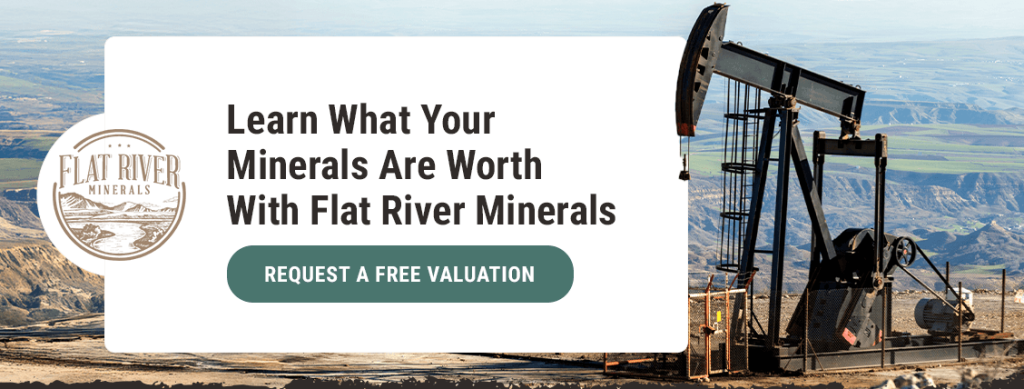
In the decade-plus since horizontal development in the Utica and Marcellus formations surged, the industry has continued to modify and improve pooling and unitization processes. As a result, we’ll likely see increased forced pooling and unitization activity in the northern Appalachian region — specifically, in Ohio and West Virginia.
If you want to make sure you get the most from your mineral rights, you need to know more than what they’re worth. You must understand how to navigate forced pooling mandates in your state. This guide explains everything you need to know.
What Is Forced Pooling?
Also known as compulsory pooling, forced pooling is a regulatory process specific to the oil and gas industry. It allows the state to require that all mineral owners in a drilling unit participate in oil or gas development, even if some refuse.
Unitization in oil and gas is the process of combining multiple oil and gas interests over a common reservoir into one large unit to maximize recovery and efficiency. It typically occurs before drilling begins once a drilling unit has been identified and is pursued by an operator.
Unlike previously developed vertical wells that descended straight from the surface, horizontal wells in the Appalachian basin are frequently more than 15,000 feet long, meaning drilling units are large — typically 400 acres and up, depending on the number of wells drilled per unit. This process helps ensure efficient resource use and protects smaller mineral owners.
All impacted landowners must share in the extracted oil and gas unit unless they opt out. While this arrangement can benefit both owners and the companies that come to drill, the legislation surrounding forced pooling has historically favored corporations over owners.
How Forced Pooling Works in Appalachia
While parts of forced pooling legislation can overlap from state to state, it’s important to understand the differences between them. The variations between Pennsylvania, Ohio and West Virginia are excellent examples.
Pennsylvania: No Forced Pooling for the Marcellus Shale
The laws surrounding forced pooling in Pennsylvania are extremely limited and do not apply to the Marcellus Shale or other unconventional shale formations. Under Title 25 Pa. Code § 79, forced pooling is only permitted for deep formations located below the Onondaga horizon. Because the Marcellus lies above the Onondaga, most modern shale development is entirely outside the reach of these pooling rules.
As a result, there is no general pooling statute in Pennsylvania for shallow or unconventional formations. Operators seeking to drill Marcellus wells must negotiate voluntary leases with every mineral owner in a proposed unit. If even one owner refuses, the operator cannot include that tract in the unit unless a separate agreement is reached or the unit is reconfigured.
In rare cases involving deep conservation wells regulated under Chapter 79, an operator can apply for a pooling order through the Department of Environmental Protection (DEP). The application must include a proposed well plan and spacing details. The DEP will notify landowners and may hold a hearing before issuing a permit and order. These cases are highly uncommon and typically unrelated to Marcellus development.
While landowners can participate as working interest partners — covering their share of drilling and completion costs in exchange for a proportionate share of revenue — this is not advisable or practical for most mineral owners. The financial exposure can be significant, and the risk of loss is high without professional expertise in oil and gas operations.
Ohio: Structured Mandatory Pooling for Fair Development
Forced pooling in Ohio falls under the Ohio Revised Code §1509.27. When an operator can’t secure all leases needed for a unit that meets the state’s spacing and acreage requirements, they may apply to the Ohio Department of Natural Resources (ODNR) for a pooling order. The operator must show the unleased tract is too small or irregular to be developed independently and that they’ve made good-faith efforts to lease the interest on fair terms.
Once filed, ODNR notifies affected mineral owners, who may request a hearing. If no hearing is requested within 30 days — or after one concludes — the Chief may issue a pooling order and drilling permit if it protects correlative rights and supports efficient development. The order outlines unit boundaries, ownership interests, production allocation and how costs will be shared.
Unleased mineral owners have three options — a) participate as working interest partners absorbing their share of drilling costs in exchange for a proportionate share of revenue, b) be deemed non-participating and receive a royalty set by the Chief based on prevailing lease terms, or c) lease to an operator or non-operator. It is always advisable to sign a lease so that, as a mineral owner, you have control over your royalty payment provisions and other important clauses. Surface owners retain control over surface use, and no drilling can occur without their written consent.
Ohio’s process aims to balance development efficiency with the rights of mineral and surface owners, providing a clear legal pathway when voluntary leasing efforts fall short.
West Virginia: Modernizing Horizontal Well Unitization
West Virginia has forced pooling governed by several state laws.
Senate Bill 694: Modernizing Horizontal Well Unitization
Effective June 7, 2022, Senate Bill 694 introduced West Virginia’s long-awaited framework for unitizing horizontal wells. The law allows operators to unitize tracts for horizontal drilling with less-than-unanimous consent, provided they obtain approval from at least 75% of royalty interest owners and control 55% of the net acreage within the proposed unit. Units are capped at 640 acres, and no more than 128 net acres can belong to non-consenting owners.
For unleased owners, SB 694 offers three options:
- Participate in the well, subject to a 200% penalty on drilling and completion costs.
- Sell their minerals to the operator.
- Be pooled by order of the Oil & Gas Conservation Commission and receive the median lease bonus and the highest royalty rate paid to any owner in the unit.
Leased owners without pooling clauses in their lease are automatically deemed pooled and are compensated similarly, receiving 25% of the weighted average lease bonus and 80% of the average royalty rate. Importantly, surface rights are not included in pooling orders — operators must still obtain a separate surface use agreement.
Cotenancy and Tract-Based Development: HB 4268 and SB 650
Before SB 694, West Virginia enacted a cotenancy statute through HB 4268 (2018), later broadened by SB 650 (2022).
These laws allow oil and gas development on a tract-by-tract basis when at least 75% of co-owners in interest consent to lease, regardless of how many cotenants exist. If a majority of owners in a single tract agree, non-consenting owners can be force-pooled into the lease and assigned the same bonus and royalty terms as those agreed to by the consenting owners. This tract-based pooling is distinct from the unit-level pooling created by SB 694.
Non-consenting cotenants are entitled to either the same royalty and bonus as their co-owners, without post-production cost deductions, or an election to participate in the well, recovering revenue only after their share of development costs is repaid at a 200% penalty. The law also protects the rights of unknown or unlocatable interest owners by holding their shares in escrow.

Tips for Mineral Rights Owners in Appalachia
If you find yourself in the middle of a forced pooling order, here are some tips to help you ensure you get fair treatment:
- Review the lease agreement: Your lease agreement should have a forced pooling clause explaining whether your land can be included in a pooled unit.
- Know your options: You can challenge a forced pooling order in court. Consulting with a legal professional can help you understand your rights and prepare the best possible argument.
- Sell your mineral rights: If you’d prefer getting the best possible price for your minerals upfront without having to wait for the well to produce, you can sell your mineral rights to a reputable buyer.
Getting in touch with a mineral rights company can help you through this process by providing expert guidance on the leasing and sales process.
Why Trust Us?
With decades of collective experience in the industry, our team consists of experts in both domestic and international mineral rights and oil and gas leases. We lean on our expertise to create helpful resources that aid mineral rights owners like you in making more informed decisions about your property.
We always ensure our content lives up to our code of cowboy ethics — we do what’s right, even if it’s not always easy. If you have any questions about the information you find on our site, please contact our team to learn more.
Learn What Your Minerals Are Worth With Flat River Minerals
If you’re a landowner in Appalachia looking for a reputable partner to buy your mineral rights, we at Flat River Minerals will make sure you get what you deserve.
We pay upfront in one lump sum rather than making you wait years to extract value from your land. Our team leverages our extensive industry experience to predict the best possible price based on market projections and production forecasts.
Interested in selling or leasing your mineral rights? Request your free valuation today to get started.

